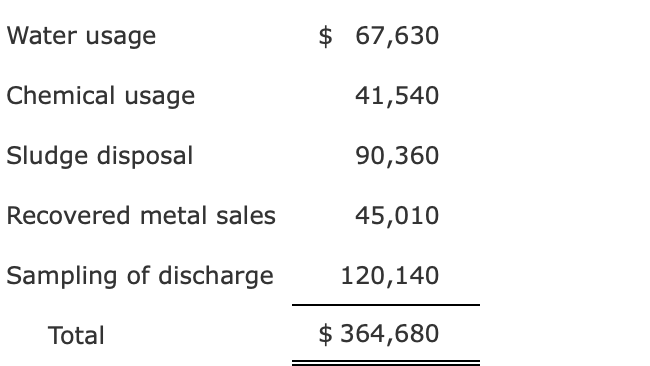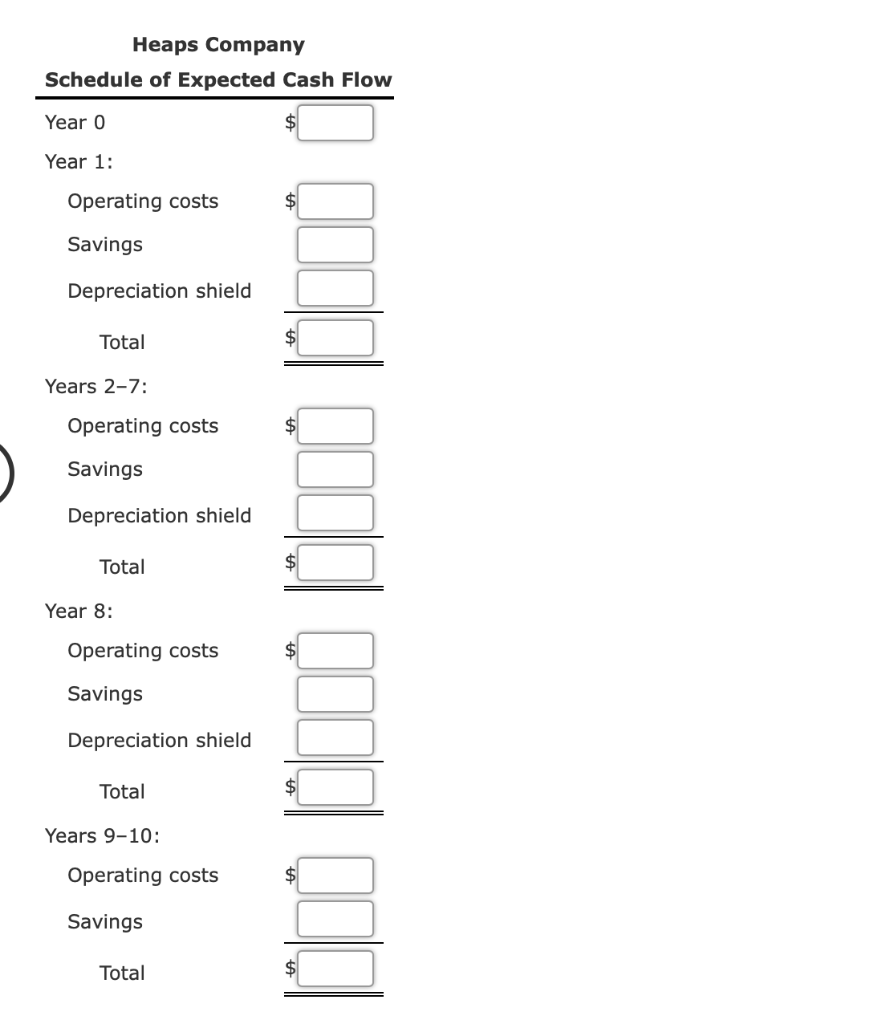Question
Pollution Prevention, P2 Investment Heaps Company produces jewelry that requires electroplating with gold, silver, and other valuable metals. Electroplating uses large amounts of water and
Pollution Prevention, P2 Investment
Heaps Company produces jewelry that requires electroplating with gold, silver, and other valuable metals. Electroplating uses large amounts of water and chemicals, producing wastewater with a number of toxic residuals. Currently, Heaps uses settlement tanks to remove waste; unfortunately, the approach is inefficient, and much of the toxic residue is left in the water that is discharged into a local river. The amount of toxic discharge exceeds the legal, allowable amounts, and the company is faced with substantial, ongoing environmental fines. The environmental violations are also drawing unfavorable public reaction, and sales are being affected. A lawsuit is also impending, which could prove to be quite costly.

Management is now considering the installation of a zero-discharge, closed-loop system to treat the wastewater. The proposed closed-loop system would not only purify the wastewater, but also produce cleaner water than that currently being used, increasing plating quality. The closed-loop system would produce only four pounds of sludge, and the sludge would be virtually pure metal, with significant market value. The system requires an investment of $625,100 and will cost $44,720 in increased annual operation plus an annual purchase of $7,210 of filtration medium. However, management projects the following savings:
The equipment qualifies as a seven-year MACRS asset. Management has decided to use straight-line depreciation for tax purposes, using the required half-year convention. The tax rate is 40 percent. The projected life of the system is 10 years. The hurdle rate is 16 percent for all capital budgeting projects, although the company's cost of capital is 12 percent.
The present value tables provided in Exhibit 19B.1 and Exhibit 19B.2 must be used to solve the following problems.
Required:
1. Based on the financial data provided, prepare a schedule of expected cash flows. Enter cash outflows as negative amounts and cash inflows as positive amounts.


Drop down option menu for questions 3 and first of 4: YES or NOT
Drop down option menu for last two questions 4: INCREASES or DECREASES
Water usage $ 67,630 Chemical usage 41,540 Sludge disposal 90,360 Recovered metal sales 45,010 Sampling of discharge 120,140 Total $ 364,680 Heaps Company Schedule of Expected Cash Flow Year o Year 1: Operating costs Savings Depreciation shield Total Years 2-7: Operating costs Savings Depreciation shield Total Year 8: Operating costs Savings Depreciation shield Total Years 9-10: Operating costs Savings Total 2. What is the payback period? Round your answer to two decimal places. years Accounting numeric field 3. Calculate the NPV of the closed-loop system. Round intermediate calculations and the final answer to the nearest dollar. $ Should the company invest in the system? 4. The calculation in Requirement 3 ignored several factors that could affect the project's viability: savings from avoiding the annual fines, positive effect on sales due to favorable environmental publicity, increased plating quality from the new system, and the avoidance of the lawsuit. Can these factors be quantified? If so, should they have been included in the analysis? Suppose, for example, that the annual fines being incurred are $74,800, the sales effect is $59,850 per year, the quality effect is not estimable, and cancellation of the lawsuit because of the new system would avoid an expected settlement at the end of Year 3 (including legal fees) of $305,500. Assuming these are all after-tax amounts what effect would their inclusion have on the payback period? On the NPV? Round payback to two decimal places and round NPV calculation and final answer to the nearest dollar. Payback by years NPV by $ Water usage $ 67,630 Chemical usage 41,540 Sludge disposal 90,360 Recovered metal sales 45,010 Sampling of discharge 120,140 Total $ 364,680 Heaps Company Schedule of Expected Cash Flow Year o Year 1: Operating costs Savings Depreciation shield Total Years 2-7: Operating costs Savings Depreciation shield Total Year 8: Operating costs Savings Depreciation shield Total Years 9-10: Operating costs Savings Total 2. What is the payback period? Round your answer to two decimal places. years Accounting numeric field 3. Calculate the NPV of the closed-loop system. Round intermediate calculations and the final answer to the nearest dollar. $ Should the company invest in the system? 4. The calculation in Requirement 3 ignored several factors that could affect the project's viability: savings from avoiding the annual fines, positive effect on sales due to favorable environmental publicity, increased plating quality from the new system, and the avoidance of the lawsuit. Can these factors be quantified? If so, should they have been included in the analysis? Suppose, for example, that the annual fines being incurred are $74,800, the sales effect is $59,850 per year, the quality effect is not estimable, and cancellation of the lawsuit because of the new system would avoid an expected settlement at the end of Year 3 (including legal fees) of $305,500. Assuming these are all after-tax amounts what effect would their inclusion have on the payback period? On the NPV? Round payback to two decimal places and round NPV calculation and final answer to the nearest dollar. Payback by years NPV by $Step by Step Solution
There are 3 Steps involved in it
Step: 1

Get Instant Access to Expert-Tailored Solutions
See step-by-step solutions with expert insights and AI powered tools for academic success
Step: 2

Step: 3

Ace Your Homework with AI
Get the answers you need in no time with our AI-driven, step-by-step assistance
Get Started


